1. Introduction
The theme of the work essentially encompasses the use of tools that provide the ability to control a process-oriented environment, aiming to achieve an efficient procedure that favors the entrepreneur is when that regulate your business with the city government. These tools revolve around BPM, which according Cruz (2008b, p. 67):
"... Is a set consisting of methodologies and technologies designed to enable business processes to integrate, logically and chronologically, customers, suppliers, partners, influencers, and employees of any element with which they can, or want to have interact giving the organization essentially complete and integrated internal and external environment of its operations and the actions of each participant in all business processes. "
The objective is to optimize the time it takes an entrepreneur to open a business regularly in the tourist city of São Roque, regarding the procedure to manage the responsibility of the municipal executive, to meet or be close to the expected grade businesswoman.
Through the use of BPM is intended to bring the study to a level of detail that allows the automation of the process, which could entail streamlining this and still meet the demands of the relaxation procedures without loss of control over events by ad-hoc -4- managers.
Of course part of the activities of the process depends on human evaluation to be generated the final product of the process of starting a business, which is the granting of operational license. Soon the theme here exposed will also lead to greater efficiency of cooperative work, since the process depends on which various actors play their part in the best way possible. These should be aware of what each must produce in order to facilitate the work of the next agent in the next activity until the end of the work, the finished product has absolute quality.
2. Background
2.1. Time for opening of Company: comparison between Brazil and other countries
The table 1and 2, Data Collection updated in June 2011 and reported in the Doing Business -5- website, show that opening a business in Brazil takes on average 119 days. Of the 190 economies surveyed, Brazil can be compared only more agile, Equatorial Guinea, Suriname, Democratic Republic of Congo and Venezuela.
Specifically in the city of São Paulo, the opening of a company (society by limited liability) midrange is made within approximately 165 days, which included 18 procedures, namely:
- Check the company name (1 hour);
- Pay your name registration (1 day);
- Register social contract (1 day);
- Get CNPJ -6- on IRS employees and record the INSS -7- (22 days);
- Confirm registration of employees at the INSS (1 day);
- Receive inspection state trading (1 day);
- Receive AIDF -8- State (1 day);
- Register with the city (5 days);
- Pay registration fee (1 day);
- Remove AIDF the municipality (1 day);tes (3 days);
- Get AVCB -9- Fire Department (120 days);
- Receive inspection from the Fire Department (included in above);
- Get the business license (included in above);
- Register employees in PIS -10- (1 day);
- Open account for FGTS -11- for employees (1 day);
- Notify the Ministry of Labour (included in previous item);
- Register with the equity Union (5 days).

Table 1 - List of top ranked countries in opening businesses in the world: procedures and duration
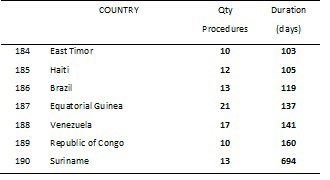
Table 2 - List of countries ranked last in opening businesses in the world: procedures and duration
3. Defining The Models And Tools For Work
To meet an accepted standard in analyzing business for the graphical representation of the process used in BPMN -12- diagrams found. This is a standard developed by BPMI-13- to provide a language that could be understood by all those who, somehow, are involved in the business environment, analysts and solution developers, and thus bridge the gap between business analysis and implementation solutions.
That way you can structure the process of a current situation and how it will be after its redesign, known as phases and is to be. For modeling software will be used BizAgi Process Modeler version 1.4.1.0 freely distributed by the company BizAgi BPM AGILITY -14- to be adherent to the BPMN standard and still allow for the export of XPDL -15- modeling, which is a language for defining business processes that can be interpreted by specialized software, called BPMS -16-.
In this paper through a BPMS will be possible to control the process flow defining its rules, its actors and its routes, making it compatible with the goal of the organization is to meet the expectations that the business has on the process time, keeping track and the quality of decisions taken between the beginning and the end, regarding the entire understanding of the flow and the consequences of actions taken. For this purpose we will use the software version 9.1.1.1010 BizAgiXpress, the company also BizAgi BPM AGILITY for presenting great ease of use, automation of a business process through parameterization without much programming effort, which approximates the tool needs the analyst business.
The methodology chosen for the data collection and its place in the modeling tools is developed by Thaddeus Cruz called for him to DOPI -17- . According Cruz(2008a, p. 133):
A methodology to document, enhance, organize, streamline processes must be able to first help analysts uncover all the information relevant to the process object of an ongoing project, and secondly to allow this whole set of information can be passed others, transmitting knowledge and creating conditions to generate more knowledge.
The methodology DOPI is being divided into three parts:
- eventOgram (decomposition of business processes in events);
- infOgram (mapping of all inputs used in the process, being physical or logical, internal or external);
- functionOgram (description of the functional roles involved in the process).
4. Computers And Organizations
Throughout history we realized the need to find a way to get people to work in cooperation with each other and with this objective have been developed computer programs, however, did not obtain succeed in its mission, primarily due to lack of development of a culture of cooperation and complicity to achieve the organization's goals, also found in the environment of this study.
The emergence of the concept of cooperative work aided by computational means have arisen from the discussion of how people worked around 1984. As Jonathan Grudin, University of California at Irvine apud Cruz (2008b, p. 63), "CSCW -18- and groupware emerged in the 80s from shared interests among product developers and IT -19- researchers in various fields." According Cruz (2008b, p. 63) was launched at a seminar organized by Iran Greif of MIT -20- and Paul Cashman of Digital Equipment Corporation at which time the concept has sparked interest in Europe and Asia. As a consequence the interest in this area, many tools and software components have been developed to support the concept of CSCW what form the set today called Groupware (CRUZ, 2008b p. 64).
The concept of CSCW would reflect the need for organizations where employees spend their work individualized for collaborative work, because the first form there is no knowledge about the process where the activities of each are integral parts, informing people of why task, the usefulness of the task and who will be sent to the product of their work (CRUZ, 2008b p. 65).
It's very different from how things unfold today in most organizations, where everyone does the best they can, but most of the time with a lot of stress and hassle, simply because there are no standards of operation, there is no guarantee of quality nor process and product quality. (CRUZ, 2008b p. 66).
Is the concept of cooperative work that is supporting the use of BPM because it is a set of elements whose purpose is to treat the organizational process holistically -21-. But first it is necessary to contextualize the situation of this object of study that is a process of public administration in order to understand your current situation and its causes, specifically regarding business processes and use of information technology tools through movement called e-gov -22-.
The use of information technology has influenced modern organizations but its indiscriminate application without proper planning and knowledge of their capabilities and limitations led to the maxim that the solution "is not and never has been in any information technology" (CRUZ, 2008b p. 39). So you cannot think about using technology to solve organizational problems without prior study and understand the organization itself outlining improvement plans, oh yes, supported by information technology.
This research verified the difficulty imposed by the lack of socialization of information because of the maintenance of privileges on certain information in some sectors of the public administration, which provides a challenge for the integration of information and services provided by State agencies.
To Ruediger (2007, p. 238) expected to change with the use of e-government can only be achieved with changes in the real foundations of the state, were mentioned: the formation of new leaders within the context of technology, group work and feedback of actions, prioritizing the use of technological resources and demand by civil society for transparency and efficiency.
It may be cited as an example of success, the Peruvian Congress, which began in 2008, the implementation of a pilot project, using the concepts of BPM, to leverage their e-government strategies .. Even in the face of growing demands for more agile and efficient, internal procedures are continually enhanced, which would provide a direct benefit to the population (SANCHEZ, 2009 p. 135).
5. BPM - Business Process Management
BPM can be defined as a set of technologies and methodologies aimed at integrating all parties involved in business processes under a single vision to provide understanding of all parties on the procedures performed in order to produce something. For Mummigatti (2009, p. 154), "Business Process Management is a set of concepts, methods and tools used define, measure and automate processes for continual improvement in operational performance." The integration provided by BPM makes possible the measurement results, which leads the process to enter into a cycle of continuous improvement, which is a fundamental requirement for survival of organizations.
The current scenario demands that we have a global perspective on the processes that produce objective, either a physical product or a service, before the market dynamics of the interconnected by information technology.
Thus managers of organizations have to adapt to new scenarios that are created in the market demand, and who is not fit ends up being excluded from this reality.
5.1. Technologies for process-oriented environments
Information technology involved in BPM part of the set termed as BPMS which can be defined according to (CRUZ, P. 2008b. 90th):
Suite of software, tools and applications of information technology whose goal is to enable the deployment of the modus operandi Business Process Management, integrating real-time customers, suppliers, partners, influencers, employees and any element that they can, want or have to interact through the automation of business processes.
It stands out as the main advantage in using a BPMS its adaptability to changes in the corporate environment.
It read as further advantages in using a BPMS change management regarding the need for change in software programming with minimal effort, the re-use of procedures in other processes, reducing costs by monitoring activities, compliance the business rules of the organization, transparency in procedures which is interesting for government agencies. The knowledge shall be in the process and not allowing people in the renewal of the workforce, modernization of systems amicably due to the modular characteristic of this type of system. (KHOSHAFIAN, 2009 pp. 125-126).
For Cruz (2008b, p. 115) are on the market a considerable range of BPMS solutions that promise to automate processes, but warns of the error of thinking that the use of a software will make us understand the business processes. This concept can bring a project to fail. Soon reaffirms that:
... must learn about business process and only then, after analyzing the universe as the business process of each software can represent, buy the product that best meets our needs and our pocket. (Cruz, 2008b p. 116)
As already mentioned and reiterated earlier, the essence of BPM rests on the concept of group work, which over the BPMS refers to CSCW or translated, group work supported by software, where the set of applications in this category can Groupware call.
According to (CRUZ, 2008b p. 117-120) BPMS could be considered an evolution of workflow software, although the point of view of the market has not reached the levels of sales expected in the 90s.
According to the WfMC -23-, 1998 apud (CRUZ, 2008b p. 120):
Workflow takes care of automating procedures where documents, information and tasks are passed between participants according to a defined set of rules in order to contribute or achieve business objectives. Source: WfMC.TCC00-1003 issue 1.1 Workflow Reference Model Printed 19/11/98, accessed on 27/01/2006.
It proved interesting to point out each of the tools that can be part of a BPMS, so in Figure 1 is a demonstration of the relationship of the various technologies that make up the universe of BPMS. A BPMS can contain the following tools: (CROSS, 2008b p. 122-123)
Figure 1 Technologies for BPMS
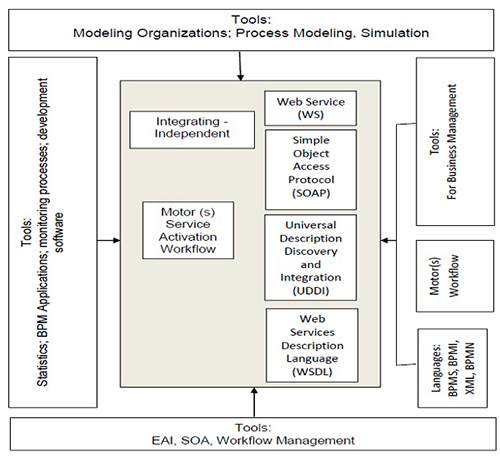
Adapted: CRUZ (2008b, p. 122)
5.2 Basics of BPD - Business Process Diagram and BPMN - Business Proccess Modeling Notation
As the site of OMG - Object Management Group, BPMN was created to be a simple mechanism that allows the understanding of all those involved with business processes. But it enables the graphical representation of processes classified as complex. This complexity is represented by four basic categories of elements that can vary depending on the event related to them, without radically changing its shape, and, according CRUZ, 2008b p. 158,
To create any business process with the proccess Business Modeling Notation (BPMN) is necessary to model the event that starts the flow execution, processing that results from this event and the results produced by the process. Business rules and deviations in the flow are modeled using gateways. A gateway is similar to the symbol used in flowchart decision (...). A process may contain subprocesses which are shown in the main flow through another Business Process Diagram (BPD) connected to the main flow (...). If a process does not contain, or in your decomposes, it is considered a sub-task (task). A task is the lowest level of any process in BPMN notation.
According to the conclusion Cruz (2008b, p. 161 ) on BPMS, pointing to the complexity of implementing this type of software, and then a job that must be executed in parts.
5.3 Methodology for modeling business processes
As CRUZ, 2008a p. 63:
Business Process is the set of activities that aims to transform inputs (inputs), adding value to them through procedures in goods or services (outputs) to be delivered and must serve customers.
For CRUZ, 2008a p. 68 macro flow develop a process, is a way to understand a process with which there is no intimacy.
In Figure 2 are exposed only the elements that compose the macro flow and a macro view of the process, it is necessary to study the process of delving into the details, because what is expected at the end of this work is to automate the process. For CRUZ, 2008a p. 74 "The whole process is composed of activities", thus the number of activities we can classify a process as simple or complex, where the case is complex, it is desirable to obtain better results in his analysis, which divide this into sub-processes in order to we focus on each part, connecting them with the inputs and outputs (Cruz, 2008a p. 75).
According CRUZ, 2008b p. 74 macrofluxo the process provides greater safety in the initial analysis making it possible to draft a proposal closer to reality studied.
Figure 2 Macro flow business process
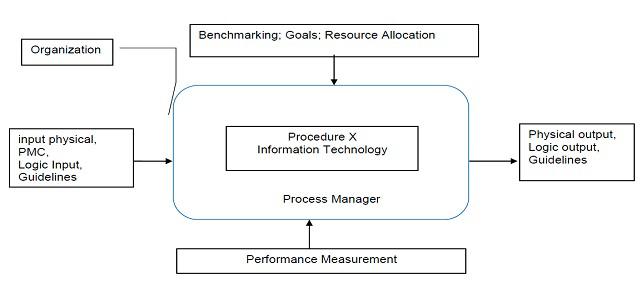
Adapted: CRUZ (2008a, p. 68)
With the knowledge of all the elements contained in a business process, you must choose a work methodology that includes an analysis of these in order to properly build a model of the studied process.
DOPI Methodology
The methodology developed by Cruz (2008a, p. 27-28) can be divided into five stages are shown below:
- Initial Analysis: In this phase arise information indicating time, cost and scope of the project analysis, as well as the objectives to be achieved, documenting the product to be delivered at the end;
- Analysis of Current Process: Understands the collection of information that will define the current process in order to improve it;
- New Process Modeling: Here is built the new process based on previously existing process or something completely different;
- Implementation of New Process: In this phase the new process starts to be operated by those who will deal with it in everyday life;
- Process Management: Due to the dynamism of the business environment is necessary that the process be managed after their deployment in order to ensure its continuous improvement.
- Participation Project Owner: Is the strong figure in the company that finances or resources to influence the project, having important role in the smooth running of the project. He must be present at all stages of the project.
When you start analyzing the existing process or create a completely new methodology established there is the use of three tools: eventOgram, infOgram and funcionOgram, cited above. In Figure 3 has an example of form input, processing and output - EPS, to be completed, as the methodology.
Figure 3 Form. E-S-P
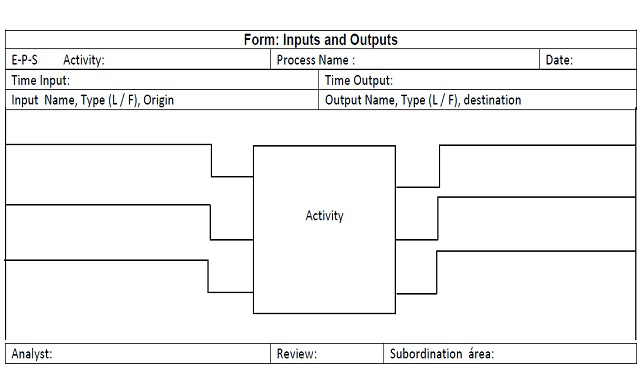
Adapted: Finamore (2009)
6. Case Study "Procedures For Starting A Business"
The case study covers the procedures for starting a business with the City of San Roque, and target analysis of all departments and subdivisions that participate directly or indirectly in the process studied. In Figure 4 were shown departments and sectors that participate in the current process.
This analysis sought to demonstrate in practical ways such as the use of methodologies and technologies within the scope of BPM can facilitate the improvement of administrative processes, especially within the civil service. In this project was given the name of e-govSR as a way to identify the generated documentation in order to favor future searches for information.
Figure 4 Chart (Current Process)
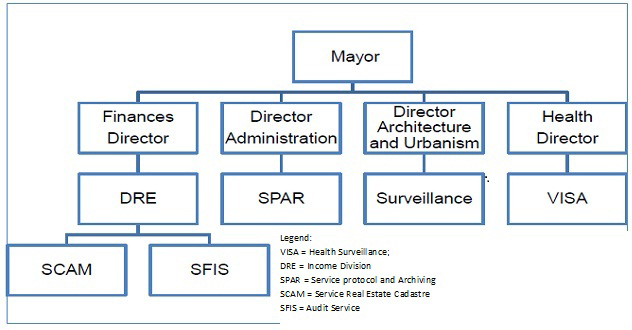
Adapted: Finamore (2009)
As a way to guide the analysis of the case is important to define some points that reference the determination of Critical Success Factors - CSF process, which will help keep us aligned with organizational goals.
As a determining factor of success has been the need to prepare the faithful mapping of the current process, and redesign that meets the objectives of the organization and provide an automation enabling flexible model, with positive influence in introducing a culture of collaboration (cooperative work ).
One should be careful in breaking barriers as opposed to changing the culture; processes with little or no documentation and trend-resistant cooperative work.
6.1 Survey Data - current situation
In the current model, information is passed to the taxpayer incomplete, forcing him to go to city hall several times behind several actors who carry with them information about sealed parts of the process, which can often generate mismatch information.
To set the process to be studied, in brief, we used a macro flow process (Figure 5) so as to start the analysis procedures for opening companies.
Figure 5 Macro flow Process Opening Business

Adapted: Finamore (2009)
6.2 Considerations guidelines process
He began the study of guidelines for analysis of the Organic Law of the Municipality (Law n. º 1801/1990), Law n. º 1335/1983) and Law no. º 2723/2002, which showed the basic guidelines for the implementation of process starting a business in São Roque. From this benchmark gave up modeling the current process in order to detail the procedures that make the process studied to detect points to be deleted in the proposed model.
6.3 Modeling the current process (as is)
The current process modeling was performed in order to facilitate the understanding of this process, which can be classified as complex by having several activities involved.
According to the analysis by the activity table of the current process, the processing time is about 955 minutes (approximately fifteen hours or two days eight working hours) a time which would be satisfactory. However, it was not included in this first estimate the waiting time that an occurrence takes to move from one sector to another.
In this case, each department change takes approximately twelve hours, or 720 minutes. Table 3 showed that the changes in the sector during the current model:
Table 3: Estimated Wait Time for change or Sector Performer
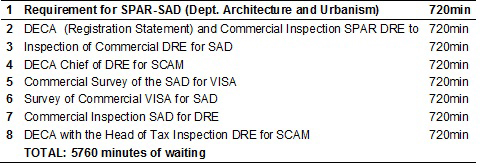
The waiting time only shows a portion of the waiting time that can exist in this process, because today there is no way to control the implemented process times, which makes the accuracy of the data studied. The executors of the activities have other functional roles within the Municipality which probably causes a longer wait in the process of starting a business in each activity presented.
6.4 Proposal for the new process (to be)
In the proposed model we tried to take into account the fundamental activities for the operationalization of the process provided by law. Within this analysis was eliminated tasks that do not add value, which became part of the automated flow, such as the record of inputs and outputs of organizational sectors. The issuance of certain documents in the form of paper was suppressed by the use of electronic mail and digital documents in PDF format. In the appendix is proposed for modeling the process of starting a business considering automation and optimization procedures.
It can be observed that the complexity of the process remained due to the amount of activities required to fulfill the legal requirements for granting of license to operate. Note also that part of the activities is carried out by a computerized system, which makes it almost immediate transmission of information which was previously supported only on paper, being this last "hand in hand". With information stored digitally process can generate other information through it, for example, the Reports of Condition and Commercial Tax. The basic information is in order Feasibility and DECA - Registration Statement city, so its fills and conference activities are critical in the process of starting a business.
By automating the process flow, the waiting time stated in Table 3 no longer exists, which makes the developer in approximately four days to reduce the waiting time for your business starts. Thus, based on the annual turnover of a company (Table 4), one gets how much each type of company, depending on its size win in four days by expediting the process of starting a business (table 5).
Table 4 – Size of Company

Source: (BNDES-National Bank for Economic and Social Development)
----
Table 5 – Revenue daily by company type

Source: (BNDES-National Bank for Economic and Social Development)
As demonstrated, the automation of processes can generate gains for the business that will benefit from the advance of the beginning of its activities.
For the City to process automation will still be an important tool to continuously improve governance, as through a BPMS will be possible to monitor the performance of each activity with respect to your executor responsible, facilitating the identification of process bottlenecks. With this control you can work best points of the process that tend to generate these bottlenecks, directing more resources to these points or improving the procedures through review and specific training.
In the present situation it is difficult to identify a bottleneck in the process, because there are no effective means of measuring the performance of activities, leaving it to run the very claim of service and responsible process to verify the real situation, sometimes without many parameters to this.
In the next section, will be exposed to the application of the concepts of BPM in a BPMS to generate a proposal for automating the process studied.
6.5 Parameterization BPMS software
The parameterization of a BPMS is to configure it based on information gathered from a business process using a methodology to collect data relevant to that task.
According to the method DOPI, it is recommended to start the mapping of events in the process for activities that directly support the end product of the process. According to the survey data, the final product of the process of starting a business is a license to operate.
Figure 6 has a form EPS filled with information about the activity that generates the operating license, and shows the inputs and outputs for the main product of the process.
Due to time constraint, EPS forms were not made for all process activities, being used only as a means to track entries and activity directly connected with the main product of the process.
To create the form BPMS, besides EventOgram (Figure 6) shows where appropriate using another tool methodology DOPI, which is infOgram. As a way of demonstrating their use, made to fill the data matrix to form DECA, which the analysis is based on a form that gives almost all activities, beyond the survey form that needs to be modified to better represent its role in the process.
The FuncionOgram was not executed because it is a tool to change the current organization, and it was deemed impractical at this time to make this kind of change, it was noted that the planned now will impact on local organizational culture, one task for future work, with specific emphasis.
Figure 6 Form EPS Generate Operating License

Adapted: Finamore (2009)
As a product of this modeling work was performed to insert the parameters raised to the BPMS BizAgiXpress version 9.1.1.1010. It may be noted that use was made of sub-processes to modularize the process, which facilitates understanding general and also the re-use of these sub-processes in other processes.
7. Conclusion
Through the process modeling was possible to map all activities under the responsibility of the municipal government, needed to start a business. Through this initial survey was developed a model to predict the change due to process automation, with an estimated reduction of 16.79% in the cost of the Resort Municipality of São Roque by eliminating tasks unrelated to the desired product, ie the license operation.
Through the survey process times could understand and eliminate initially a waiting time between processing activities, of 5760 minutes, or 4 days, which would represent a gain for the entrepreneur estimated US$ 166,660 considering, for example, a medium-sized company.
With the use of BPM, we can realize the importance of analyzing a complex process through the parts that compose it so that it is possible to mount the scenario with higher fidelity on the reality of the organization. The concepts used are shown valuable in the task of raising the level of integration between processes, people and IT as the goal of adding value to the products offered by any type of business.
For government organizations, the use of the concepts of BPM in administration can bring benefits to society, in view of the continuous increase in the efficiency of government actions that may be more accurate, more agile and less costly. Is it possible, yes, do more with fewer resources, and align the services provided by the State to the demands of the information society, subject to constant changes generated by a global environment. However, it is necessary to eliminate cultural barriers that prevail in a government environment that impede the socialization of information, hinder cooperative work and so do not allow the effective use of IT.
References
BIZAGI BPM AGILITY LMTD.. BizAgi, Business Process Management Software, BPM Software, BPM Suite, BPM. BizAgi. Available in:
<http://www.bizagi.com/eng/>. Accessed at: 12 Aug. 2011. (Text in Portuguese)
NBESD - National Bank for Economic and Social Development. Available in: <http://www.bndes.gov.br/SiteBNDES/bndes/bndes_pt/Navegacao_Suplementar/Perfil/porte.html>. Accessed at: 10 Sept. 2011. (Text in Portuguese)
CRUZ, Tadeu. BPM & BPMS Business Process Management & Business Process Management Systems. Rio de Janeiro: Brasport, 2008b. (Text in Portuguese)
CRUZ, Tadeu. Systems, methods & processes: managing organizations through business processes. 2.ed. São Paulo: Atlas, 2008a. (Text in Portuguese)
Doing Business. Doing Business Measuring business regulations. Opening of Enterprises. Available in: <http://portugues.doingbusiness.org/ExploreTopics/StartingBusiness/?direction=Asc&sort=3>. Accessed at: 31 Oct. 2011. (Text in Portuguese)
FINAMORE, Willian M. The use of Business Process Management (BPM) for optimization and automation of procedures for starting a business in scope the Municipality of the tourist city of São Roque. 2009. 144 p. Completion of course work. (Bachelor of Information Systems) Academia de Ensino Superior, São Roque, 2009. (Text in Portuguese)
KHOSHAFIAN, Dr.Setrag. Managing Change with Re-Usable Assets for Government Agencies. In:FISCHER, Layna. 2009 BPM and Workflow Handbook: Spotlight on Government. Lighthouse Point: Future Strategies Inc., 2009.p.115-126.
MUMMIGATTI, Vinaykumar S. Business Transformation Blueprint - BPM as Key Enabler. In:FISCHER, Layna. 2009 BPM and Workflow Handbook: Spotlight on Government. Lighthouse Point : Future Strategies Inc., 2009.p.153-160.
OMG Object Management Group. BPMN 1.1. Available in: em:<http://www.omg.org/spec/BPMN/1.1/>. Accessed at: 07 Oct.2011.
Ruediger, Marco Aurélio. Perspectives of governance in the information age: state and society civil. In: MARTINS, Paulo Emilíio Matos; PIERANTI,Octavio Penna. State and Public Management: Visions of Contemporary Brazil. 2ª Ed. Rio de Janeiro: Editora FGV, 2007.p.233-256. (Text in Portuguese)
SANCHEZ, Rocio Angelico. Streamlining the Congress of the Republic of Peru e-Government. In: FISCHER, Layna. 2009 BPM and Workflow Handbook: Spotlight on Government. Lighthouse Point : Future Strategies Inc., 2009.p.127-136.
SÃO ROQUE. 1983. Law n. º 1335, of 7 november 1983. Gives new wording of Articles 98, 100 and 102 of Law n. º 678, of December 31, 1966, and 16 of Law n. º 709, of September 20, 1967, and other provisions. São Roque, São Paulo, Brasil: s.n., of 7 de November 1983. (Text in Portuguese)
SÃO ROQUE. Law n. º 1550, of March 16, 1987. Discipline expedition of license fee and other measures. São Roque, São Paulo, Brazil: sn, March 16, 1987. (Text in Portuguese)
SÃO ROQUE. Law n. º 1801 of April 5, 1990. THE PEOPLE OF SÃO ROQUE AND YOURS REPRESENTATIVES, gathered at City Hall Constituent, following the dictates of the federal constitution and state constitution, labored to elevate the City to the most modern and efficient democratic parameters and ... São Roque, São Paulo, Brazil: sn, April 5, 1990. (Text in Portuguese)
SÃO ROQUE. Law No. 2723 of September 23, 2002. Provides for public prices and several services of the Municipal Sanitary Surveillance. São Roque, São Paulo, Brazil: sn, September 23, 2002. (Text in Portuguese)
Figure 7 - Appendix A Proposed Model

Adapted: Finamore (2009)